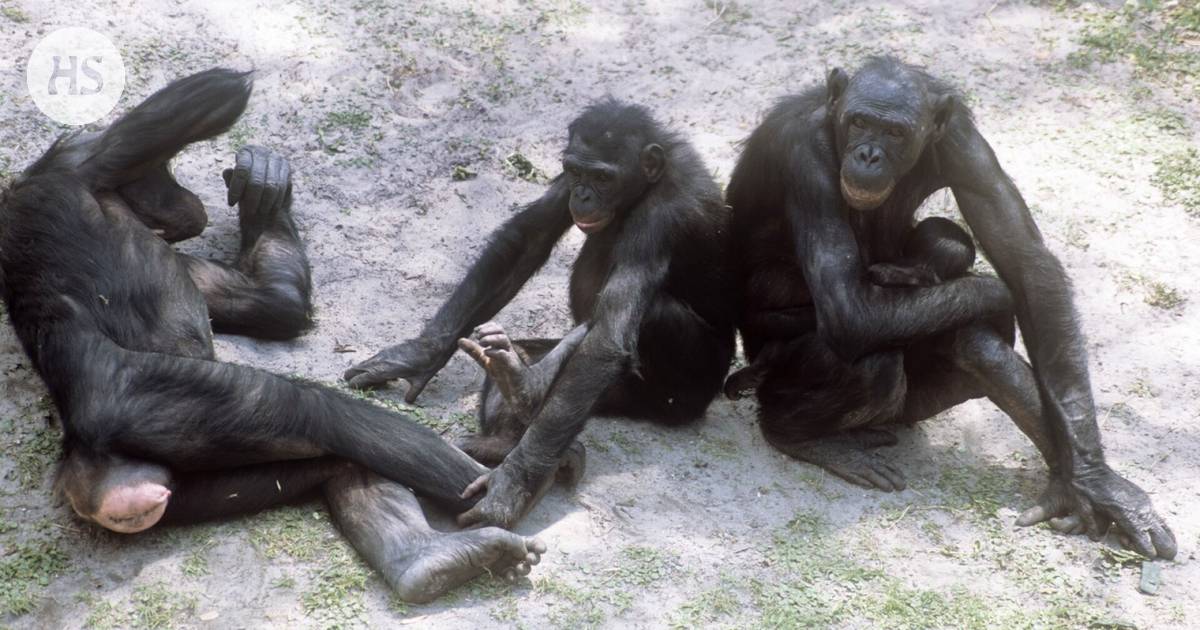from the 1990s from bonobos or pygmy chimpanzees (Pan paniscus) have been told the same message: they are a peaceful and agreeable monkey species.
Bonobos settle their disputes by kissing, caressing and sex. The pack is led by females.
Our other close relatives, i.e. chimpanzees (Pan troglodytes) are like the dark side compared to bonobos.
In a herd of chimpanzees, males compete for leadership. When in a tight spot, the male can kill his fellow species. There is constant debate about food, and there is a strict order of values in eating it. Bosses eat first.
Females are taken by force. Males form gangs. Herds are constantly fighting over territories. Cubs constantly seek refuge from females.
About zoologists many have suggested that there is more bonobo in man than chimpanzee. Now there have been cracks in this truth.
Our perceptions of bonobos should perhaps be changed, says a primate researcher and anthropologist Maud Mouginot.
“A bonobo is not a hippie monkey,” says Mouginot. He is a biological anthropologist at Boston University. The peace-loving term for bonobos was coined by an animal rights activist Sally Coxe sometime in 2006.
Mouginot and his group have recently followed the everyday life of bonobos longer than other primate researchers.
Bonobos live in isolated rainforests. Therefore, they have been followed less than chimpanzees. Chimpanzees live not only in rainforests but also in other woodlands and savannahs.
Mouginot and his group observed the everyday life of pygmy chimpanzees in their natural habitats, in the rainforests of the Democratic Republic of the Congo in 2018.
An estimated 15,000 bonobos live there in an area slightly larger than Finland, which is getting smaller and fragmented every year.
Before that, Mouginot followed the chimpanzees in Tanzania.
The two chimpanzee communities monitored lived in Gombe National Park. In the Congo, he followed 12 male bonobos in three communities in the Kokolopori animal reserve.
In both in some places, the researchers interpreted the monkeys’ aggression using the same method: they observed pushing, hitting, biting, kicking, rushing and chasing towards another male or the pack.
A total of more than 9,300 hours of monitoring was accumulated over the course of a couple of years, from morning to evening. The research was presented scientific journal Current Biology.
Mouginot’s conclusion is that male bonobos show a lot of actions indicating aggression.
There are almost three times more of them than their cousins, chimpanzees.
Male chimpanzees start their day in gentle moods. In bonobos, on the other hand, the males seemed to wake up ready for a fight.
However, in bonobo aggression, the male usually attacks another male.
Chimpanzees, on the other hand, form gangs when they start brawling, kertoo The New York Times. It is a way for males to protect their territory.
In bonobos, females copulate, not males.
Maybe it’s easier for bonbos to break away from aggression, Mouginot thinks. In a female-led community, males do not have to fear being forced to join groups formed by males.
This may be the reason why the aggression of bonobos is quantitatively higher.
Mougoni calculated that the bonobos that directed the most aggression towards others also mated the most.
Bonobos very rarely directed aggression towards females.
The males politely followed the females while the monkey pack moved forward in search of food in the rainforest, he says nature magazine Mongabay.
Primates researcher Mouginot does not want to draw conclusions about us, the human species, as related as these species are.
In evolution, we separated from chimpanzees approximately seven million years ago. This has been proven with the help of dna studies.
About five million years ago, bonobos separated into their own species in East Africa.
According to Mouginot, it is better to look and compare the ways these monkey species have developed to survive.
The behavior of monkeys can be affected by the different conditions of the habitats. Knowing about monkeys can help if we want to save these relatives from extinction.
Some researchers say that Mouginot has misused the word “aggression” in his research.
Bonobos’ disputes about the right to mate should not be confused with aggression, says an Australian zoologist, for example Gisela Kaplan of New Scientist magazine by.
Primate researcher and anthropologist Brian Hare says the study now sets new standards for comparing bonobos and chimpanzees.
Hare reminds us that there are still clear differences between monkey species. For example, bonobos have not been seen to kill their fellow species.
“Chimpanzees murder, bonobos don’t,” he reminds.
